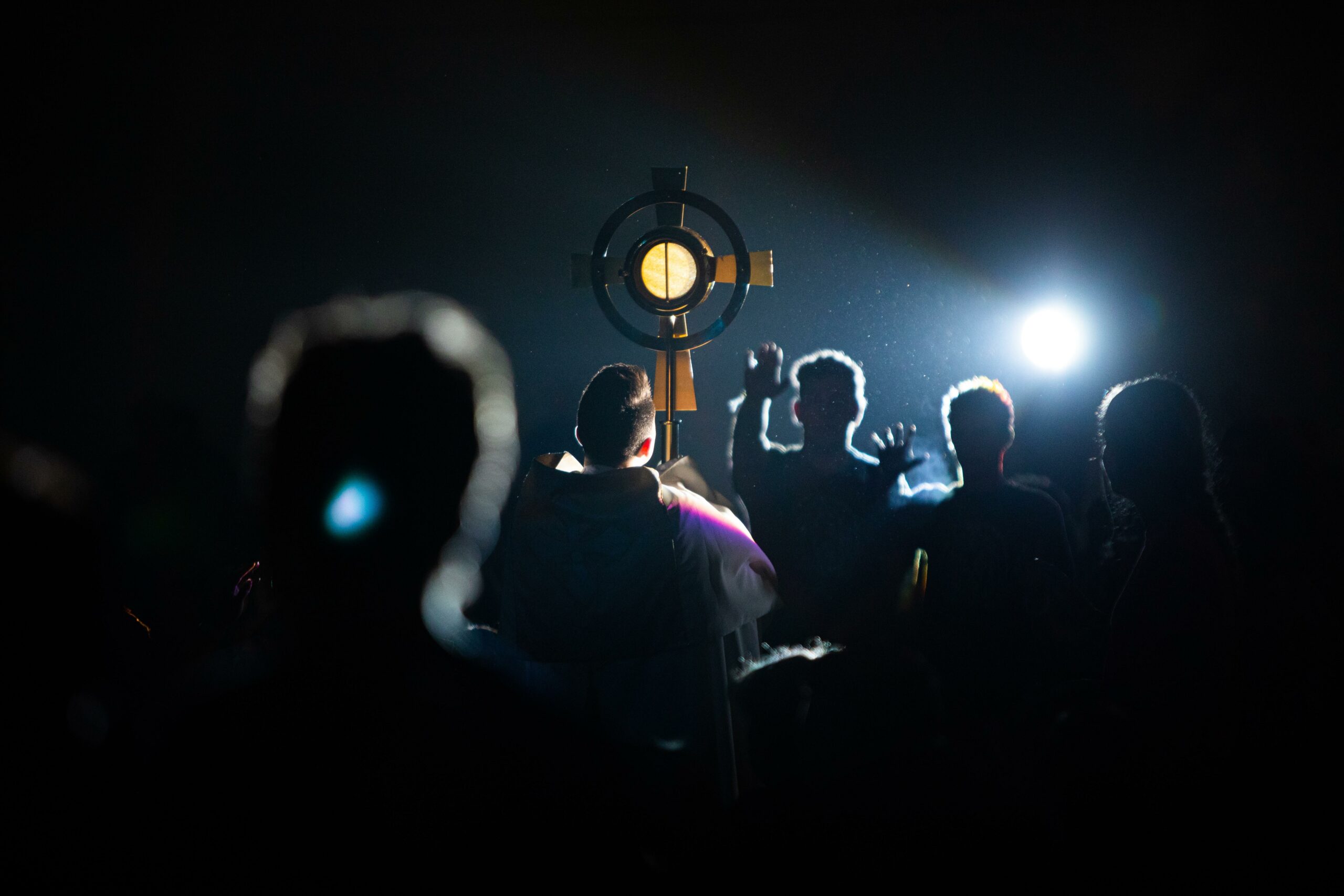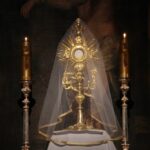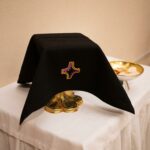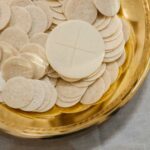Are you ready to uncover the hidden truths and fascinating wonders of Eucharistic adoration? Get ready to embark on a journey through the depths of spirituality and cultural beliefs as we unveil 10 captivating facts about this sacred practice. As a seasoned researcher in comparative theology, I have delved deep into the significance and practices associated with Eucharistic adoration. In this article, we will explore the rich tapestry of beliefs and rituals, shedding light on a world filled with mystery and devotion. So, fasten your seatbelts and prepare to discover the enchanting secrets of Eucharistic adoration!

Facts About Eucharistic Adoration
Eucharistic adoration is a powerful and deeply spiritual practice that is observed by various Christian traditions, including Western Catholicism, Anglicanism, Methodism, and some Lutheran traditions. Whether you’re already familiar with this practice or just starting to explore its significance, here are some fascinating facts about Eucharistic adoration that shed light on this profound expression of faith.
1. The Blessed Sacrament and the Act of Adoration
During Eucharistic adoration, the focus is on the Blessed Sacrament, which refers to the consecrated bread and wine that Catholics believe to be the body and blood of Christ. The faithful engage in a display of reverence and worship, acknowledging the real presence of Jesus in the consecrated elements. This act of adoration is a tangible expression of faith, deepening the spiritual connection with Christ.
“Eucharistic adoration allows believers to directly encounter the divine presence in a profound and intimate manner.”
2. Uniting with Christ Through the Eucharist
Receiving the Eucharist is a vital practice in the Catholic faith. The act of partaking in the consecrated elements symbolizes the believer’s unity with Christ. It is believed to strengthen the spiritual bond between the individual and Jesus, forging a personal relationship that transcends earthly boundaries.
“Through the Eucharist, believers are united with Christ, experiencing a transformative encounter that nourishes their souls.”
3. The Power to Overcome Sin
One of the profound aspects of the Eucharist is its ability to destroy venial sin, which are lesser offenses that damage the soul but do not completely cut off one’s relationship with God. Catholics believe that through the reception of the Eucharist, God’s grace has the power to cleanse and heal, bringing forgiveness and redemption.
“The Eucharist not only nourishes the soul but also has the power to cleanse and heal, serving as a means of spiritual purification.”
4. Historical Preparation for the Eucharist
Before instituting the sacrament of the Eucharist, Jesus foreshadowed its significance through various acts and teachings. By doing so, he prepared his disciples for the profound mystery of the Eucharist. Jesus used parables, performed miracles, and shared meals to create a rich theological foundation for this sacred practice.
“Jesus’ preparation for the Eucharist shows the intentional and profound significance he assigned to this sacrament.”
5. The Real Presence of Christ
The theological understanding of the Eucharist goes beyond mere symbolism. According to Catholic doctrine, the Eucharist is not merely a representation of Christ’s body and blood; it is the true presence of Christ. This belief, known as transubstantiation, affirms that the substance of the bread and wine is transformed into the body and blood of Christ, while the physical properties remain unchanged.
“Catholics hold a deep belief in the real presence of Christ within the Eucharist, making it more than a mere symbol or metaphor.”
6. Devotion and Worship through Adoration
Eucharistic adoration is an act of devotion and worship that allows individuals to express their love and reverence for Jesus Christ. This practice can occur when the Eucharist is exposed, highlighted and displayed for individual prayer and meditation, or when it is reserved in a tabernacle, allowing for continuous worship and adoration. Through this devotional act, believers deepen their spiritual connection and seek solace in the presence of God.
“Eucharistic adoration serves as a profound expression of devotion and worship, allowing believers to experience a deep sense of peace and solace in the presence of the divine.”
7. Historical Roots and Development of Eucharistic Adoration
The theological basis and ritual for Eucharistic adoration were developed and formalized during the 11th century. This period witnessed a deepening of Eucharistic devotion and a desire to manifest outward reverence for the Blessed Sacrament. Throughout history, Eucharistic adoration has evolved through various rituals and regulations, culminating in the establishment of the Rite of Eucharistic Adoration.
“The historical development of Eucharistic adoration reflects a deepening devotion and formalization of practices to honor the Blessed Sacrament.”
8. Eucharistic Adoration Beyond Catholicism
While Eucharistic adoration is primarily associated with Catholicism, it is interesting to note that certain Lutheran and Anglican traditions also practice this devotion. Although it may vary in form and theological understanding, the central focus on adoring and worshiping Christ in the Eucharist remains a unifying factor across various Christian denominations.
“Eucharistic adoration extends beyond Catholicism, showcasing its universal significance in fostering a renewed spiritual connection with Christ.”
9. Strengthening Faith and Cultivating Relationship
Engaging in Eucharistic adoration provides an opportunity for believers to spend time with the Lord, deepening their spiritual connection and fostering a profound relationship with Christ. Through moments of silence, prayer, and personal reflection, individuals can find peace, guidance, and strength in the midst of life’s challenges.
“Eucharistic adoration offers believers a sacred space for personal encounters with Christ, enabling them to strengthen their faith and find solace amidst life’s uncertainties.”
10. A Profound Path to Spiritual Enrichment
Eucharistic adoration can be seen as a spiritual journey, where believers embark on a path of devotion, self-reflection, and communion with God. This practice offers a way to deepen one’s spirituality, develop a greater understanding of the divine mysteries, and cultivate a genuine love for Jesus Christ.
“Eucharistic adoration serves as a profound and transformative path to spiritual enrichment, leading believers to a deeper encounter with the divine.”
As you delve into the world of Eucharistic adoration, immerse yourself in these fascinating facts that uncover the richness and diversity of this sacred practice. Whether you approach it from a place of curiosity or as a devoted practitioner, Eucharistic adoration invites us all to experience the profound love and presence of Jesus Christ.
The Eucharist is a central sacrament in the Catholic Church, representing the body and blood of Jesus Christ. If you’re curious about this sacred ritual and want to learn some fascinating facts about the Eucharist, click here for a comprehensive list of insights. Dive into the rich history and symbolism of this important sacrament, and gain a deeper understanding of its significance in Christian faith. Discover how the Eucharist has evolved over time and its role in fostering spiritual connection. Explore the spiritual nourishment and communal bonding that comes with partaking in this sacred ritual. To unravel the mysteries surrounding the Eucharist, follow this link to uncover an array of intriguing facts: facts about the eucharist.
Facts about the Eucharistic Adoration
Do you want to uncover fascinating insights about Eucharistic Adoration? Look no further! Our article, “Facts about the Eucharistic Adoration,” is your ultimate guide to understanding and appreciating this profound practice. In this compelling read, you’ll embark on a journey through time, exploring the origins and significance of Eucharistic Adoration. Discover the awe-inspiring truths about the transformative power of this sacred ritual. With each turn of the page, you’ll gain a deeper understanding of the profound connection between the adoration of the Eucharist and the spiritual nourishment it provides. So, without further ado, immerse yourself in this captivating article and embrace the divine mysteries that await you. Start your journey here: eucharistic adoration facts.
Engross yourself in the depths of knowledge regarding the adoration of the Eucharist. Our article, “Facts about the Adoration of the Eucharist,” is a treasure trove of intriguing information that will leave you captivated. Unveil the enigmatic aspects of this spiritual practice and uncover the profound truths that lie beneath the surface. With every word, you’ll be drawn closer to understanding the deep reverence and devotion that characterize the adoration of the Eucharist. Begin your exploration of this sacred ritual by clicking here: facts about adoration of the eucharist.
Are you seeking the profound truths behind Eucharistic Adoration? “Truths about Eucharistic Adoration” is the article you’ve been waiting for. Delve into the mystical realm of adoring the Eucharist and unravel the secrets that have fascinated believers for centuries. Discover the transformative power that lies within this intimate experience. Embark on a spiritual journey and immerse yourself in the divine presence that awaits through Eucharistic Adoration. Unveil the truths that will ignite your soul. Your sacred exploration begins here: truths about eucharistic adoration.
3 Eucharistic Miracles Examined by Top Scientists: Unexplained Divine Occurrences
[youtube v=”93cqR-nwI8s”]
A Glimpse into Miracles Beyond Scientific Explanation
Throughout history, there have been numerous accounts of Eucharistic miracles that have baffled scientists and left them without any logical answers. In this article, we will delve into three scientifically proven Eucharistic miracles that have been examined, scrutinized, and investigated by top scientists worldwide. These miracles are so profound that they defy scientific explanation, leaving us with a single conclusion – the occurrence must be divine.
The Eucharistic Miracle of Lanciano, Italy
In the 8th century, in the town of Lanciano, Italy, a pre-celebrating mass was consumed with doubts about the true presence of God’s body and blood in the Eucharist. However, something extraordinary happened during the mass. As the priest uttered the words of consecration, “This is my body, this is my blood,” the bread miraculously transformed into living flesh, and the wine coagulated into blood, forming five globules.
Despite skepticism, an investigation was conducted by the local archbishop, and the miracle was officially approved by the Church. However, it was not until 1971 that the specimens were analyzed by Dr. Odiado Linole, a renowned professor in anatomy, histology, chemistry, clinical microscopy, and former head of the laboratory of pathological anatomy at the Hospital of Arizo. His findings astonished him, as well as the scientific community. In 1981, Dr. Rogario Batelli, a retired professor of human anatomy, confirmed Linole’s analysis.
The results revealed that the flesh was cardiac tissue of type AB, while the blood appeared fresh, contrary to its supposed age of 1,200 years. Additionally, there were no traces of preservatives. These findings left the scientific world in shock, offering no explanation for this miraculous event. To this day, anyone can visit the flesh and blood of the Eucharistic miracle at the Church of San Francisco in Lanciano, Italy.
“The scientific community was left astounded, unable to explain this miracle.”
The Eucharistic Miracle in Bonazare’s, Argentina
On August 18th, 1996, a remarkable incident occurred during a holy mass at a Catholic church in Bonazare’s, Argentina. After distributing holy communion, a woman approached Father Alejandro Possette and informed him that she had found a discarded host on a candle holder at the back of the church. Unable to consume it himself, Father Possette placed the host in a dish of water and stored it in the tabernacle.
To his astonishment, when he opened the tabernacle on Monday, August 26th, he discovered that the host had transformed into a bloody substance. Father Possette reported the miracle to Cardinal Jorge Begoli, who would later become Pope Francis. Cardinal Begoli instructed Father Possette to have the host professionally photographed, and the photos were taken on September 6th, 1996.
With no visible decomposition of the host, Cardinal Begoli decided to have it scientifically examined. Without revealing the origin of the substance, Dr. Frederick Zugiba, a well-known cardiologist and forensic pathologist from Columbia University, was among the scientists chosen to analyze it. Dr. Zugiba determined that the substance was real flesh and blood containing human DNA. He further concluded that it was a fragment of heart muscle from the left ventricle, displaying signs of severe stress.
“The presence of human DNA in the analyzed substance confirmed the inexplicable nature of this miracle.”
The Eucharistic Miracle in Texas, Mexico
In October 2006, during a mass in Texas, Mexico, a supernatural event unfolded that left everyone astonished. Two priests and a religious sister were distributing communion when the sister noticed tears in her eyes. To her shock, the host she was about to distribute emitted a reddish substance.
Prompted by this extraordinary occurrence, Bishop Elijo Zavala Castro established a theological commission of investigation. Dr. Ricardo Castanon Gomez and his team of scientists were called upon to conduct scientific research into the validity of the miracle. Their findings were nothing short of astounding. The reddish substance analyzed was indeed human blood, containing hemoglobin and DNA of human origin.
By employing various forensic methodologies, the scientists excluded the possibility of external tampering, confirming that the blood originated within the host. The blood type was determined to be AB, matching the blood type found in the host of Lanciano and the Holy Shroud of Turin. The analysis also revealed that the upper layer of the blood had coagulated since October 2006, while fresh blood was found in the underlying internal layers in February 2010.
“The presence of fresh blood without any natural explanations solidifies this miracle as unexplained and divine.”
In conclusion, these three scientifically proven Eucharistic miracles leave us in awe of their inexplicable nature. They have been subjected to rigorous scientific examination by renowned experts who were unable to provide any logical explanation for these divine occurrences. These miracles serve as a testament to the power and mystery of the Eucharist, reinforcing the age-old belief in the true presence of Christ.
FAQ
Question 1
What is Eucharistic adoration?
Answer 1
Eucharistic adoration is a devotional practice where the faithful adore the Blessed Sacrament, primarily in Western Catholicism, but also practiced in Anglicanism, Methodism, and some Lutheran traditions.
Question 2
What is the theological basis for Eucharistic adoration?
Answer 2
The theological basis for Eucharistic adoration was developed in the 11th century, emphasizing the true presence of Christ in the Eucharist and promoting devotion and worship of Jesus Christ.
Question 3
What is the significance of Eucharistic adoration for believers?
Answer 3
Eucharistic adoration promotes a relationship with Christ and strengthens the believer’s faith by allowing them to spend time with the Lord and deepen their spiritual connection.
Question 4
When does Eucharistic adoration occur?
Answer 4
Eucharistic adoration may occur when the Eucharist is exposed or when it is reserved in a tabernacle, providing opportunities for the faithful to engage in this practice.
Question 5
Is Eucharistic adoration limited to Catholicism?
Answer 5
No, Eucharistic adoration is not limited to Catholicism. It is also practiced in certain Lutheran and Anglican traditions, reflecting the diverse expressions of this devotional practice.
“`json
“`
- Senior at What Age: Benefits & Eligibility Guide - March 29, 2025
- Unlocking Senior Benefits: How Old is a Senior? Your Complete Guide - March 29, 2025
- Master Russian Politeness:A Guide to Saying Please - March 29, 2025
















